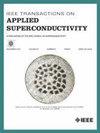Design and Short-Circuit Analysis of a 1 MW Superconducting Generator for Electric Aircraft
IF 1.7
3区 物理与天体物理
Q3 ENGINEERING, ELECTRICAL & ELECTRONIC
引用次数: 0
Abstract
High temperature superconducting (HTS) synchronous machines hold significant potential for future electric propulsion systems in aircraft. HTS machines feature larger electromagnetic airgap and smaller reactance than their conventional counterparts, resulting in higher fault currents and instantaneous AC losses in HTS field windings during sudden short circuits at machine terminals. This paper first presents a multi-objective optimization process for a 1 MW, 6000 rpm HTS synchronous generator and compares the performance with and without a rotor back iron. Second, a finite element (FE) model, which couples rotating dynamics, external circuits, and an HTS numerical method based on the求助全文
约1分钟内获得全文
求助全文
来源期刊

IEEE Transactions on Applied Superconductivity
工程技术-工程:电子与电气
CiteScore
3.50
自引率
33.30%
发文量
650
审稿时长
2.3 months
期刊介绍:
IEEE Transactions on Applied Superconductivity (TAS) contains articles on the applications of superconductivity and other relevant technology. Electronic applications include analog and digital circuits employing thin films and active devices such as Josephson junctions. Large scale applications include magnets for power applications such as motors and generators, for magnetic resonance, for accelerators, and cable applications such as power transmission.
 求助内容:
求助内容: 应助结果提醒方式:
应助结果提醒方式:


